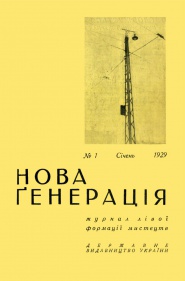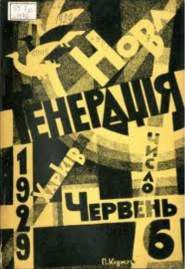Nova generatsiia
Nova generatsiia [Нова генерація: Журнал лівої формації мистецтв; New Generation] was a literary organisation of futurists established in Kharkiv in 1927 by former members of the Association of Panfuturists, Mykhailo Semenko, Geo Shkurupii, Oleksii Poltoratsky, A. Chuzhy, Mykola Skuba, and others, and new members such as Dmytro Buzko. Its program embraced the propagandistic slogans of internationalism and proletarian culture and was combined with an imperative to modernize Ukrainian literature by putting it in touch with contemporary literary currents in the West. In 1929 the name was changed to the All-Ukrainian Association of Workers of Communist Culture, and in 1930, to the Alliance of Proletarian Writers in Ukraine. In 1931 the organisation was forced to disband. Most of its members were executed during the Stalinist terror, although some, such as O. Poltoratsky, succumbed to pressure and adopted the Party line. (Source).
Contents
Journal[edit]
The organisation published between October 1927 and December 1930 a monthly journal under its own name (Nova generatsiia), edited by Mykhailo Semenko. Much of its contents were devoted to contemporary literary polemics and to the popularization of currents in literature and art in the West (eg, G. Apollinaire, Le Corbusier, W. Baumeister). Among the more frequent contributors were Amvrosii Buchma, V. Ver, Oleksa Vlyzko, Hryhorii (Heo) Koliada, Favst Lopatynsky, Semen Skliarenko, E. Strikha (Kost Burevii), Leonid Skrypnyk, and Leonid Chernov. 36 issues appeared. (Source).
Issues[edit]
 Nova generatsiia 1 (Jan 1929), PDF (45 mb). |
- The above PDF is sourced from the Library Of Ukrainian Art.
Literature[edit]
- Myroslava Mudrak, The New Generation and Artistic Modernism in the Ukraine, Ann Arbor, MI: UMI Research Press, 1986, x+282 pp. (English)
- Nova Generatsiia, in Encyclopedia of Ukraine, vol. 3, 1993.
- Nova generatsiia (journal), in Encyclopedia of Ukraine, vol. 3, 1993.
- Oleh S. Ilnytzkyj (ed.), The New Generation, 1927–1930: A Comprehensive Index, CIUS Press, 1998, 55 pp. Cover, Frontispiece, Contents, Introduction, (2), Detailed contents, (2), (3), (4), (5), (6), Index, (2), (3), (4), (5), Publisher.
- Oleh S. Ilnytzkyj, "Under imperial eyes in Kyiv and Kharkiv magazines: Ukrains'ka khata (1909-14), Muzahet (1919), Mystetstvo (1919), Katafalk iskusstva (1922), Semafor u maibutnie (1922), Honh komunkul'ta (1924), Nova generatsiia (1927-30), Avangard: Al'manakh proletars'kykh myttsiv Novoi generatsii (1930)", in The Oxford Critical and Cultural History of Modernist Magazines: Vol. 3: Europe 1880-1940, Oxford University Press, 2013. [1]
- Nova generatsii in Glossary of Literary Terms (in Ukrainian)
See also[edit]
Links[edit]
| Avant-garde and modernist magazines | ||
|---|---|---|
|
Poesia (1905-09, 1920), Der Sturm (1910-32), Blast (1914-15), The Egoist (1914-19), The Little Review (1914-29), 291 (1915-16), MA (1916-25), De Stijl (1917-20, 1921-32), Dada (1917-21), Noi (1917-25), 391 (1917-24), Zenit (1921-26), Broom (1921-24), Veshch/Gegenstand/Objet (1922), Die Form (1922, 1925-35), Contimporanul (1922-32), Secession (1922-24), Klaxon (1922-23), Merz (1923-32), LEF (1923-25), G (1923-26), Irradiador (1923), Sovremennaya architektura (1926-30), Novyi LEF (1927-29), ReD (1927-31), Close Up (1927-33), transition (1927-38). | ||
| Full list | ||
|---|---|---|
|
Entretiens politiques et littéraires (1890-93), Moderní revue (1894-1925), Volné směry (1897-1948), Mir iskusstva (1898-1904), Vesy (1904-09), Poesia (1905-09, 1920), Zolotoe runo (1906-10), The Mask (1908-29), Apollon (1909-17), Ukraïnska khata (1909-14), Der Sturm (1910-32), Thalia (1910-13), Rhythm (1911-13), Trudy i dni (1912), Simbolul (1912), The Glebe (1913-14), Ocharovannyi strannik (1913-16), Revolution (1913), Blast (1914-15), The Little Review (1914-29), Futuristy (1914), Zeit-Echo (1914-17), The Egoist (1914-19), L'Élan (1915-16), 291 (1915-16), Orpheu (1915), La Balza futurista (1915), MA (1916-25), SIC (1916-19), flamman (1916-21), The Blindman (1917), Nord-Sud (1917-18), De Stijl (1917-20, 1921-32), Dada (1917-21), Klingen (1917-20, 1942), Noi (1917-25), 391 (1917-24), Modernisme et compréhension (1917), Anarkhiia (1917-18), Iskusstvo kommuny (1918-19), Formiści (1919-21), S4N (1919-25), La Cité (1919-35), Aujourd'hui (1919), Exlex (1919-20), L'Esprit nouveau (1920-25), Orfeus (1920-21), Action (1920-22), Proverbe (1920-22), Ça ira (1920-23), Zenit (1921-26), Kinofon (1921-22), Het Overzicht (1921-25), Jednodńuwka futurystuw (1921), Nowa sztuka (1921-22), Broom (1921-24), Život (1921-48), Creación (1921-24), Jar-Ptitza (1921-26), New York Dada (1921), Aventure (1921-22), Spolokhi (1921-23), Gargoyle (1921-22), Veshch/Gegenstand/Objet (1922), Kino-fot (1922-23), Le Coeur à barbe (1922), Die Form (1922, 1925-35), 7 Arts (1922-28), Manomètre (1922-28), Ultra (1922), Út (1922-25), Dada-Jok (1922), Dada Tank (1922), Dada Jazz (1922), Mécano (1922-23), Contimporanul (1922-32), Zwrotnica (1922-23, 1926-27), Secession (1922-24), Stavba (1922-38), Gostinitsa dlya puteshestvuyuschih v prekrasnom (1922-24), Putevi (1922-24), Klaxon (1922-23), Akasztott Ember (1922-23), MSS (1922-23), Perevoz Dada (1922-49), Egység (1922-24), L'Architecture vivante (1923-33), Merz (1923-32), LEF (1923-25), G (1923-26), The Next Call (1923-26), Russkoye iskusstvo (1923), Disk (1923-25), Irradiador (1923), Surréalisme (1924), Almanach Nowej Sztuki (1924-25), La Révolution surréaliste (1924-29), Blok (1924-26), Pásmo (1924-26), DAV (1924-37), Bulletin de l'Effort moderne (1924-27), ABC (1924-28), CAP (1924-28), Athena (1924-25), Punct (1924-25), 75HP (1924), Le Tour de Babel (1925), Periszkop (1925-26), Integral (1925-28), Praesens (1926, 1930), Sovremennaya architektura (1926-30), bauhaus (1926-31), Das neue Frankfurt (1926-31), L'Art cinématographique (1926-31), Dokumentum (1926-27), Kritisk Revy (1926-28), Novyi LEF (1927-29), i 10 (1927-29), Nova generatsiia (1927-30), ReD (1927-31), Dźwignia (1927-28), Tank (1927-28), Close Up (1927-33), Horizont (1927-32), transition (1927-38), Discontinuité (1928), Munka (1928-39), Quosego (1928-29), Urmuz (1928), Unu (1928-32), Revista de Antropofagia (1928-29), 50 u Evropi (1928-29), Documents (1929-30), L'Art Contemporain - Sztuka Współczesna (1929-30), Adam (1929-40), Art concret (1930), Zvěrokruh (1930), Alge (1930-31), Le Surréalisme au service de la révolution (1930-33), Levá fronta (1930-33), Kvart (1930-37, 1945-49), Nová Bratislava (1931-32), Linja (1931-33), Spektrum (1931-33), Nadrealizam danas i ovde (1931-32), Ulise (1932-33), Die neue Stadt (1932-33), Mouvement (1933), PLAN (1933-36), Karavan (1934-35), Ekran (1934), Axis (1935-37), Acéphale (1936-39), Telehor (1936), aka (1937-38), Plastique (1937-39), Plus (1938-39), Les Réverbères (1938-39). | ||
